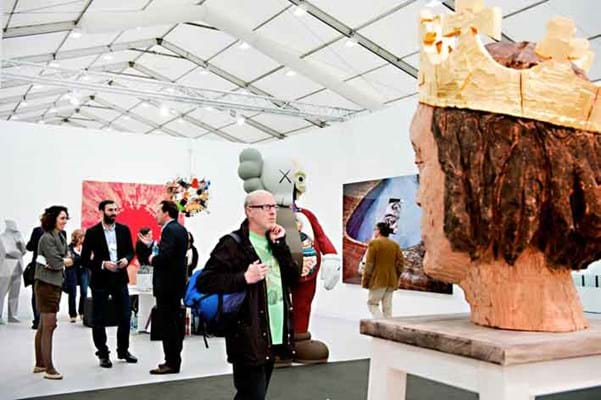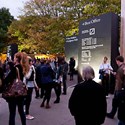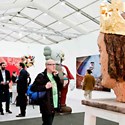This Contemporary art fair attracts around 60,000 visitors from curators and celebrity VIPs to art students, tourists and the general public and everyone in-between - it is the Tate Modern of the art fair world.
It's not particularly smart, the simple, utilitarian interior belies the huge price tags, and there is none of the sumptuous decoration of a fair such as Masterpiece, for instance.
But whatever you may think of Frieze, it's a phenomenon and the fact that it is irresistible to so many raises the familiar question of why can't the wider art market - Old Master pictures or medieval sculpture for example - create the same excitement?
Well, this year, for the first time, the organisers broaden their horizons beyond Contemporary art and we will see if some of the Frieze magic can rub off on 'historical art'.
The new Frieze Masters fair will run alongside Frieze Art Fair from October 11-14 in Regent's Park, dedicated to paintings and sculpture produced before the year 2000 with the aim of presenting "a unique perspective on the relationship between old and new art".
The exhibitor list of 90 galleries was released in May; a roll call of international names at the top of their fields from London antiquities dealer Rupert Wace and Parisian Old Master specialists De Jonckheere through to tribal art dealer Entwistle and the big brand, Modern and Contemporary galleries such as Pace and Gagosian who have locations all over the world.
"The idea is to do something unique," says Frieze Masters director Victoria Siddall. "There would be no point in trying to do something like another fair because the marketplace is too crowded."
We meet in the Frieze offices which are, as you would expect, the epitome of nonchalant pared-back style, situated on the top floor of Rochelle School, a sprawling Victorian building that is also home to a restaurant and designers' studios in Shoreditch, in the heart of East London's contemporary gallery land. TheFriezeteam moved here about a year and a half ago, needing more space, and it has a young, fresh feel - "we used to cook lunch and eat together every day, but now we don't have time," says Victoria.
No wonder, as foundersAmanda SharpandMatthew Slotoverhave this year added two more fairs to the Frieze stable: Frieze New York, which had its inaugural fair in May, and Frieze Masters.
Origins of Frieze Masters
So how did the Masters idea first come about and why did they think it could work in an already teeming fairs calendar?
"There were a variety of reasons," Victoria says. "In the same way that the founders stepped in to fill the gap in London for a big Contemporary fair, they saw the need for a fair like this in London. So it came from us to a certain extent.
"But also over the years we had a lot of dealers applying to Frieze Art Fair who were not Contemporary dealers. These were some of the best galleries in the world, but we had to tell them it was not the right fair for them, but it gave us the idea, knowing that this level of gallery wanted to have a presence in London."
Following the closure of the Grosvenor House fair in 2009, SLAD (the Society of London Art Dealers) approached Frieze about organising another high-end fair in London, another factor that convinced them there was a demand. In May 2010 Victoria was given a year to put together a convincing business plan for the event, researching the market, finding a venue and contacting dealers to gauge their response to the idea.
"Once we had a critical mass of good dealers who are enthusiastic about the idea, we felt confident going ahead," she says.
After graduating in English and philosophy from Bristol University, Victoria started work immediately at Christie's in their proposals department, working with all the departments to secure consignments. She joined Frieze in 2004, working in sponsorship where she brought in Deutsche Bank, Cartier, BMW and Pommery as backers. She then became more involved in the organisation of the fair and her role changed to head of development, looking at improvements.
"It was about what the galleries wanted, so it was a natural step to investigate the possibility of another fair. At the end of the year, if it was decided Frieze Masters could go ahead, then I could run it, so obviously I had a very vested interest in making it work!" adds Victoria.
No-one can doubt the Frieze brand's knowledge and success within the Contemporary market. But to gain kudos within the Old Master field and the wider art market they needed to enlist the help of some influential names to add some authoritative weight to the fair within this new territory.
Over the year of talking to many dealers, Victoria noticed that the same names cropped up time and again as respected and, importantly, well-liked dealers in their fields.
Eighteen months ago, she started inviting them to join a selection committee and the resulting seven members of the team are names many will know. They number three Old Master specialists - Jean-Luc Baroni from London, Fabrizio Moretti, who has galleries in Florence, London and New York, and Richard Feigen from New York. Alongside these are Sam Fogg, a London specialist in Medieval, Islamic and Indian art; the London Modern art dealer Thomas Gibson; Ivan Wirth, whose Modern and Contemporary art gallery Hauser & Wirth has bases in London, New York and Zurich; and, from San Francisco, Anthony Meier, who deals in Post War and Contemporary art.
"They've been amazing," says Victoria, "because although people respect Frieze as organisers of a Contemporary fair, this is a completely new area so we needed people who were influential and added gravitas to the project.
"It was great to be able to show that these people were already committed and enthusiastic about the concept of the fair and they've been instrumental in both deciding how it will work and also pulling the galleries in."
Moretti's Motivation
Speaking to ATG on the phone a few days later,Fabrizio Morettiexplained that he was enthusiastic about the project from the start.
"I was delighted to be asked by Victoria because I've always been a great believer in mixing Old Master and Contemporary pieces, in mixing periods without looking at the age. The important thing is the quality of both. It will be unlike other fairs, a chance to see Jean-Luc Baroni exhibiting alongside Gagosian."
Talk of Frieze Masters was rife at this year's TEFAF Maastricht fair in March, unsurprisingly as it was the month that the two-day-long selection meeting took place. Anyone could submit an application and a detailed proposal of what they planned to bring and how they would present it. "We wanted the galleries to challenge themselves to think about how they could present their work differently, not create the same traditional stand as they would for other fairs," says Victoria.
"The idea was that it was a fair and transparent process, so that everyone could put forward what they would plan to do rather than doing it by invitation only. We didn't want to rule out unexpected applications from people we wouldn't have thought of but actually would make a great addition to the fair. And we did have some of those."
The fair was oversubscribed and those who did not make the cut could appeal, which was discussed at a later meeting. But Victoria hopes that the mix they have achieved will work well and she is pleased with the breadth and quality: "We've got one tapestry dealer, one antiquities dealer, one oceanic art dealer, all of whom are at the top of their field."
The layout will be completely mixed, so exhibitors have been asked to think about the fact that, for example, although they might be bringing medieval sculpture this might be sitting alongside a Dan Flavin light installation or a Donald Judd sculpture on the stand next door.
Floor Plan
So how will it look? The interior of the Neptunus semi-permanent structure will be markedly more luxurious than Frieze Art Fair's stark aesthetic and the 10,000 sq m footprint is half the size. It has been designed by the Manhattan-based architect and interior designer Annabelle Selldorf, the woman behind the renovation of galleries such as Haunch of Venison in London, Zurich and New York, Hauser & Wirth on both Savile Row and Piccadilly, and New York's Neue Galerie. So she certainly knows this market, both Modern and Old Master.
The brief was to create "a space in which ancient and modern art could be shown side by side and feel comfortable" and the look will be "modern, minimal but also very elegant". While at many fairs nowadays, dealers are given free rein to paint their stands as they please, here they have a strict palette to chose from: three shades of grey and a white for the walls, a white, grey or black ceiling and a uniform grey floor.
"The idea is that people won't walk round the fair and see a stand with red walls and think 'that's not for me', to stop people from instantly discriminating because of the architecture. Hopefully they will look at a work of art because it's a great work of art, without thinking when it was made. It makes it easier for us to mix the periods too," says Victoria.
The 79 galleries in the main body of the fair have stands between 40 and 120 sq m in size, while those in Spotlight (22 in all) each have 30 sq m stands on which to mount solo artist presentations - a more affordable option "to encourage geographical diversity", featuring some smaller galleries from places such as Romania, Hong Kong and São Paulo.
Shuttles and Chauffeurs
Initially, many thought that Frieze Masters would be right next door to Frieze Art Fair in the south of Regent's Park, but in fact it will sit in the north-east corner of the park next to London Zoo, a 15-minute walk away. It's a pleasant walk through the park, but given how notoriously lazy fair-goers can be, how will the organisers ensure that visitors buy a joint ticket (£35) and visit both fairs?
There will be a minibus shuttle for general public and chauffeur-driven BMWs for key clients. "I think the distance between is purely a psychological barrier. We've learnt a lot about transport from Frieze New York and if we can get New Yorkers on a ferry up the East River I am sure that we can encourage our visitors to take a short walk through Regent's Park. However, we also have shuttle services between the two fairs," says Victoria.
"The main thing for the galleries is that the serious collectors come. We've got an amazing list of contacts from the contemporary fair some of whom do not come to London every October because their tastes are more for established contemporary and Modern works. This has been supplemented by collectors who have been put forward by the exhibitors at Masters."
Frieze Masters will open the day before Frieze Art Fair, so there is no clash of opening previews, and they have forged links with the National Gallery, British Museum and V&A, which they say has strengthened relations with some curators.
"Curators have always been very important to us and we've always been delighted by the huge number of international curators who take the time to come to Frieze every year," says Victoria.
They worked with Nicholas Penny, director of the National Gallery, to create the marketing material, using close-up details of a 15th century Annunciation scene by Carlo Crivelli from the gallery's collection across the whole marketing campaign and website.
"The idea is that it's hard to place the painting in terms of period - the bricks look quite Modern British while the wings are clearly from a Renaissance work."
Wider Market
The so-called Frieze Week has become a phenomenon in London as the fair has sparked a host of auctions, fairs and exhibitions around town at the same time, which makes London a honeypot for the Contemporary art world during that week. Frieze Masters could make this week more relevant for the wider art market.
"We hope that galleries across the board will benefit and that the number of visitors that Frieze brings to London will be felt across the city with an economic boost for different types of business be it in hotels, restaurants or shops as well in art galleries themselves," adds Victoria.
Of course, one of the other events in town at the same time is the successful French-run fair Pavilion of Art & Design London in Berkeley Square (October 10-14), now in its sixth year and owned by Patrick Perrin. There is definite crossover between the two fairs, and some previous exhibitors from PAD London exhibit at Frieze Masters instead this year.
Victoria is reluctant to comment on another fair but, when asked how she thinks the two events will sit alongside each other, she says: "Frieze Masters will show art throughout the ages rather than just modern. Secondly, there's no furniture or jewellery at Frieze Masters, it's just art, focusing on painting and sculpture.
"The idea that it shows the thread throughout the whole of art history, from ancient through to Contemporary, I think makes it quite unique," she says.
"It's a tendency that people have to say 'maybe it will be like this fair or that fair', and they will until they have seen it. But I hope that when they visit they will see that it is not like any other fairs."
High expectations ride on her shoulders but many in this industry, young and old, would love to be in her shoes.








